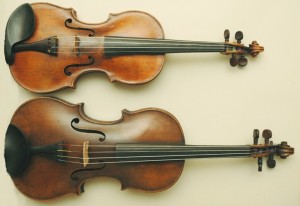 I play both violin and viola, and I’d never have it any other way. Yes, remaining proficient on both takes more practice time, and yes, it’s more expensive to pay for upkeep on two instruments and bows…but it’s totally worth it! Here are the reasons why I’ll always have two cases in my music room:
I play both violin and viola, and I’d never have it any other way. Yes, remaining proficient on both takes more practice time, and yes, it’s more expensive to pay for upkeep on two instruments and bows…but it’s totally worth it! Here are the reasons why I’ll always have two cases in my music room:
1) If you play both violin and viola, you never have to give up the unique characteristics of each instrument. If you’re a violinist who has never played a viola, trust me: the resonance of the C-string vibrating against your throat is deeply comforting, and once you’ve experienced it, an incredibly difficult feeling to give up. On the other hand, the quicksilver responsiveness of the violin’s E-string is just as seductive, albeit in a totally different way. But if you play both instruments, you don’t need to choose between these equally amazing musical experiences.
2) Playing both instruments teaches adaptability. Not only do you have to move between instruments that are sized differently and require different techniques to play, you have to switch clefs, too! As tricky as this might be, it’s a good workout for the brain…and as with everything else in music, the more you practice, the better you get at it.
3) Focusing on producing a beautiful viola tone teaches you a lot about producing a beautiful tone on violin. I didn’t begin to understand the concept of bow arm weight until I had to make a viola speak.
Mozart’s Sinfonia Concertante for Violin, Viola and Orchestra
4) Finding opportunities to play in ensembles gets a lot easier. I can go to an ensemble and audition for positions in the first violins, second violins, or violas. This puts me at an immediate advantage. I also get more paying gigs, which is nice (and helps make up for the above-mentioned extra expense!).
5) You get to hear beloved repertoire in new and exciting ways. My favorite symphony is Beethoven’s seventh, especially that magisterial slow movement. At different times, I’ve had the chance to enjoy it from two very different perspectives in both the second violin section and the viola section. Playing different parts of the same piece granted me a deeper appreciation for what was happening in the score, making me fall in love with Beethoven’s genius all over again.
6) You’ll always find repertoire and technical challenges for your mood. Feeling like you want to focus on position work, speed, and learning lots of notes fast? The violin is waiting for you. (Sometimes it’s so much fun to be flashy!) Or are you in a mood to think about tone quality, relaxation, and situational awareness? The viola beckons. (Sometimes it’s such a drag to be flashy!) Either way, you’re guaranteed challenges whose solutions you’ll be able to bring to the other instrument.
7) Best of all, you can tell the most brutal viola jokes imaginable and get away with it!
Being bi-instrumental is one of the most rewarding musical choices I’ve ever made. Don’t be afraid of the challenge of learning both!
Itzhak Perlman & Pinchas Zukerman – Handel Halvorsen Passacaglia




